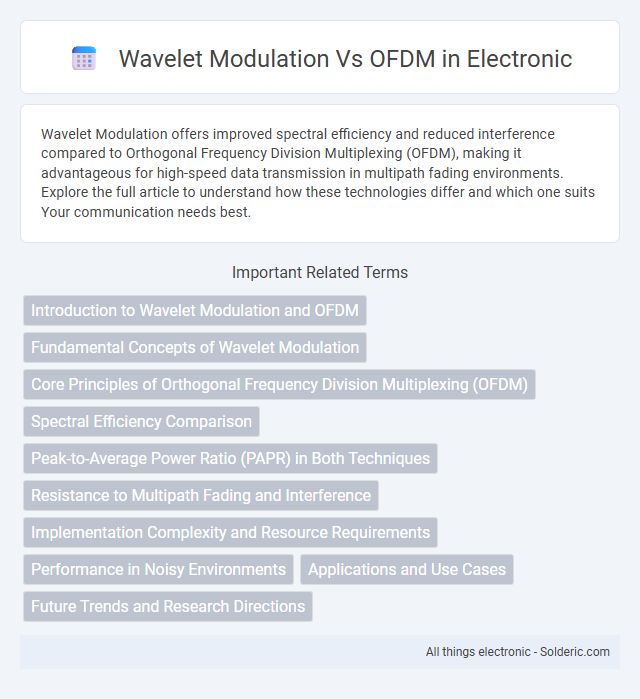Wavelet Modulation offers improved spectral efficiency and reduced interference compared to Orthogonal Frequency Division Multiplexing (OFDM), making it advantageous for high-speed data transmission in multipath fading environments. Explore the full article to understand how these technologies differ and which one suits Your communication needs best.
Comparison Table
| Feature | Wavelet Modulation | OFDM (Orthogonal Frequency Division Multiplexing) |
|---|---|---|
| Definition | Modulation using wavelet transforms for signal processing | Multicarrier modulation using orthogonal subcarriers |
| Spectral Efficiency | Higher due to time-frequency localization | High, but can suffer from spectral leakage |
| Inter-symbol Interference (ISI) | Lower ISI due to better time-frequency concentration | Handled by cyclic prefix, but can increase overhead |
| Implementation Complexity | Higher complexity due to wavelet transform computation | Relatively lower; based on FFT/IFFT |
| Resistance to Multipath Fading | Good, enhanced robustness with wavelet basis | Effective, especially with proper equalization |
| Peak-to-Average Power Ratio (PAPR) | Generally lower PAPR | Higher PAPR, a limitation in power amplifier design |
| Application | Emerging in advanced communication systems | Widely used in LTE, Wi-Fi, DVB-T |
Introduction to Wavelet Modulation and OFDM
Wavelet Modulation utilizes wavelet transforms to more efficiently represent signals with time-frequency localization, offering improved resistance to multipath fading and reduced spectral leakage compared to traditional methods. Orthogonal Frequency Division Multiplexing (OFDM) divides the available spectrum into multiple orthogonal subcarriers, enhancing data transmission rates and robustness against inter-symbol interference in broadband communication systems. Both techniques optimize bandwidth utilization but differ fundamentally in signal representation and resistance to channel impairments.
Fundamental Concepts of Wavelet Modulation
Wavelet modulation uses wavelet transforms to encode data across multiple scales and frequencies, enabling efficient time-frequency localization and reduced inter-symbol interference. Unlike OFDM, which employs orthogonal subcarriers with fixed durations, wavelet modulation adapts to signal characteristics through scalable basis functions, providing enhanced robustness in multipath and fading environments. Your communication system can benefit from wavelet modulation's improved spectral efficiency and resilience in complex wireless channels.
Core Principles of Orthogonal Frequency Division Multiplexing (OFDM)
Orthogonal Frequency Division Multiplexing (OFDM) divides a high-rate data stream into multiple lower-rate streams transmitted simultaneously over orthogonal subcarriers, minimizing intersymbol interference and maximizing spectral efficiency. Each subcarrier is modulated using schemes like QAM or PSK, and the orthogonality ensures minimal crosstalk between subchannels, boosting data integrity in multipath environments. Your communication system benefits from OFDM's robustness and efficient bandwidth utilization, making it ideal for applications like Wi-Fi, LTE, and 5G.
Spectral Efficiency Comparison
Wavelet Modulation offers higher spectral efficiency compared to OFDM by utilizing overlapping wavelet functions that reduce guard band requirements and minimize inter-symbol interference. OFDM relies on orthogonal subcarriers with cyclic prefixes that consume additional bandwidth, lowering overall spectral efficiency. Studies show Wavelet Modulation can achieve up to 20% improvement in bandwidth utilization in multipath fading environments.
Peak-to-Average Power Ratio (PAPR) in Both Techniques
Wavelet Modulation exhibits a lower Peak-to-Average Power Ratio (PAPR) compared to Orthogonal Frequency Division Multiplexing (OFDM), which improves power amplifier efficiency and reduces signal distortion in wireless communication systems. OFDM signals typically have high PAPR due to the constructive summation of multiple subcarriers, leading to nonlinear distortion and increased out-of-band emissions. The inherently better time-frequency localization of wavelets results in a more constant envelope, making wavelet modulation attractive for power-constrained and nonlinear channel environments.
Resistance to Multipath Fading and Interference
Wavelet Modulation offers enhanced resistance to multipath fading by utilizing compactly supported wavelet basis functions that provide better time-frequency localization compared to OFDM's rectangular pulses. This improved localization reduces inter-symbol interference and Doppler sensitivity, making wavelet modulation more robust in multipath environments. In contrast, OFDM is more prone to inter-carrier interference and requires a cyclic prefix to mitigate multipath effects, leading to spectral inefficiencies and increased susceptibility to frequency-selective fading.
Implementation Complexity and Resource Requirements
Wavelet Modulation generally requires lower computational complexity and less stringent synchronization compared to OFDM, making it more efficient in environments with limited processing resources. OFDM demands more intricate Fast Fourier Transform (FFT) operations, cyclic prefix insertion, and precise frequency synchronization, increasing implementation complexity and power consumption. Your choice depends on system constraints, where wavelet-based schemes excel in resource-limited scenarios while OFDM provides robustness at the cost of higher computational overhead.
Performance in Noisy Environments
Wavelet Modulation offers superior performance in noisy environments due to its inherent time-frequency localization, which reduces inter-symbol interference and improves signal robustness. OFDM, while effective in handling multipath fading, often suffers from high peak-to-average power ratio (PAPR) that can degrade performance under severe noise conditions. For your communication system, choosing Wavelet Modulation can enhance noise resilience and maintain higher data integrity compared to OFDM in challenging channel scenarios.
Applications and Use Cases
Wavelet Modulation is favored in applications requiring high resistance to multipath interference and efficient bandwidth utilization, such as underwater communications and radar systems, due to its compact energy distribution and low side lobes. OFDM dominates broadband wireless systems, including Wi-Fi, LTE, and 5G, because of its robustness in frequency-selective fading environments and ability to support high data rates with simple equalization. Your choice between Wavelet Modulation and OFDM depends on the specific use case demanding either enhanced spectral efficiency and resilience or widespread compatibility and mature infrastructure support.
Future Trends and Research Directions
Wavelet Modulation offers promising future trends in spectral efficiency and resistance to multipath interference, making it a strong candidate for next-generation wireless communication systems. Research directions focus on optimizing wavelet packet design and adaptive algorithms to enhance robustness in dynamic environments, surpassing traditional OFDM limitations. Your development efforts can benefit from exploring hybrid systems combining wavelet modulation's flexibility with OFDM's proven performance for 5G and beyond networks.
Wavelet Modulation vs OFDM Infographic

 solderic.com
solderic.com